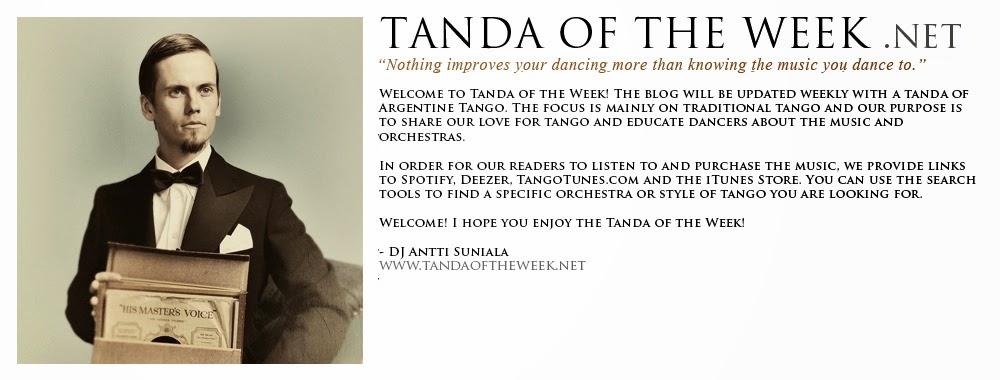So as mentioned in the welcoming post a tanda is a set of three to four songs of either tango, vals or milonga* (style of music) played at a milonga* (a tango party) [* The word "milonga" has a number of meanings. It's ok to be confused]. Usually tangos are always played in tandas of four songs while valses and milongas are more commonly played in tandas of three songs. A normal order of tandas is two tandas of tango, one tanda of vals, two tandas of tango and one tanda of milonga. In milongas the dj will play a tanda followed by a cortina (a short song of different style) which will mark the ending of the tanda. During the cortina the dancers will leave the floor and look for their next partners. After the cortina finishes the dj continues with another tanda and after finding a new partner the dancers will get on the dance floor again.
Creating a tanda
It is preferred that a tanda consists of songs from the same orchestra, style and time period. This rule is made having the dancers best interest in mind. When the dj follows this rule the dancers can recognice from the first song of the tanda if they want to dance to the tanda and then choose who they would like to dance it with. For example if the first song is a smooth romantic tango from late 30's from for example Francisco Canaro, the dancers can expect the same style to continue throughout the tanda. If the dj doesn't follow this rule then the dancers don't know what to expect and dance in fear of having to leave the dance floor when the romantic mood might be broken by a randomly selected dramatic uptempo tango from the late 50's from Osvaldo Pugliese. Even though the song itself would be a great one, such change of orchestra, style and time period is too drastic and will destroy the mood and a lot of dancers will leave the dance floor and complain about the dj-ing.
The dj also should play a lot of tandas which have songs that are well known and popular. These are the songs that are played over and over again in milongas everywhere and the dancers know them by heart. The better the dancers know the songs they are dancing to the better they can interpet and dance the music. Playing too many tandas of more unknown tangos will leave the dancers feeling uncomfortable. There's a saying that all the dj's play the same 200-300 tangos just in different order. This is very true in some ways but in every milonga there's space for a couple of tandas of less known tangos and also a lot of possibilities for personality and creativity in how you organize your tandas and when you choose to play them.
The order of the songs
Another important thing in creating tandas is choosing in which order to play the songs. The first song is very important in describing the mood of the tanda and it also needs to be one of the, if not the most danceable song of the tanda making sure everybody wants to get on the dance floor. The second song should continue the same emotion and quality as the first one. The fourth song has to be the best song of the tanda or second to only the first one leaving the dancers in a good mood after the tanda. The third one could be considered as the least important of the songs but it doesn't mean you can use any song you like on this spot. In fact sometimes the third song is of great importance to the tanda. For example if I've played two uptempo songs I might drop the tempo a bit for the third one to make the final uptempo song stand out more and also give better structure to the tanda. A bit of a curve in the emotions even inside a tanda can be good. If you play a tanda of very dramatic tangos the dancers will get very deep in this emotion and it can be a bit tiresome to keep the same intensity of emotion for four songs. Again the third song could be "mildly less dramatic" to give the dancers a bit of a breather without breaking the mood.
The atmosphere of the milonga
During the milonga the dj should play tandas from all the most popular orchestras like Canaro, D'Arienzo, Pugliese, Caló, Di Sarli, Tanturi, Troilo and D'agostino. A good dj can sense the emotions of the dancers and choose the right tandas for the right moment and will know which tanda to play after the other. In the beginning of the milonga it is good to play more cheerful tandas and save the most melancholic and dramatic tandas to be played later during the night. I always try to finish the night off with a very romantic tanda in the style of "the last slow songs of the night". It is also a common practice to play "La Cumparsita" as the very last song of the milonga.
This was a quick introduction to tandas and how a dj of argentine tango works. Later I will get into more detail about tandas and even how to bend the rules in good fashion.

0 kommenttia:
Post a Comment